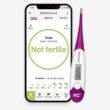Tracking your cycle. The fertility awareness method. Natural birth control. Thousands of women Google these exact phrases every month, and the numbers keep growing. If this sounds familiar, then maybe you, like many other women out there, are sick (perhaps literally) of the status quo when it comes to birth control. Maybe you’re sick of the side effects of the Pill, the hassle of having to take something every day, or maybe you had a really bad experience with an IUD. If this has been your experience with family planning thus far, take heart that there are better options out there—and in coming to Natural Womanhood, you’re on the right track to finding them.
Even if you’re completely new to learning about fertility awareness methods (FAMs) or natural family planning (NFP), you may have already heard or read about multiple unfamiliar words or phrases, like “basal body temperature” and “cervical mucus.” Maybe you’ve even got a girlfriend or two who uses an app to track these signs for health or family planning purposes. In this article, we’re going to explain exactly what cervical mucus is, what it looks like, how to observe and track it, and why it’s so important for monitoring your fertility.
What is cervical mucus?
Now, bear with us here. If you’ve never heard anything about cervical mucus before, it might seem a little graphic. But the truth is, there is nothing dirty or gross about cervical mucus; in fact, you’ve probably been feeling it (and maybe even off-handedly observing it) since before you started your first period as a teen. It’s a sign that your reproductive system is healthy and functioning as it ought to.
Have you ever noticed that sometimes when you wipe after using the bathroom, it feels a little slippery, even wet? That sometimes, the toilet paper seems to slick over your vulva, while at other times, it’s a bit “rougher” of a sensation? That sensation, in a nutshell, is cervical mucus. In fact, sometimes, you might even notice something sticky or stretchy, clear, white, or yellowish, left behind on the toilet paper. Again, that is cervical mucus!
So what is it, exactly? Cervical mucus is mucus made and released by the cervix (the “neck” or lower portion of the uterus), and it is primarily made up of nutrient-rich electrolytes, proteins, and water. It is produced in the cervical crypts, i.e., pockets or finger-like projections lining the walls of the cervix. Cervical mucus production and quality are directly related to the cyclic rise and fall of estrogen and progesterone over the course of your menstrual cycle.
As estrogen dramatically rises in the days immediately preceding ovulation (the release of an egg from one of your ovaries), cervical mucus production ramps up as much as ten-fold. That’s when you’ll start to get the “slippery” feeling over your vulva when you wipe, and when you may also notice that you feel “slick” down there as you move about your day. The observable quality of the mucus also changes from thick and tacky to slippery and stretchy.
These cyclical, observable changes in sensation and characteristics are why most fertility awareness methods (FAMs) have some component of cervical mucus observation. This pattern is obvious enough that over the course of a menstrual cycle, a trained FAM user can confidently identify fertility versus infertility (i.e., the likelihood that she will get pregnant if she has sex) simply by watching and interpreting her mucus sign. (Below, you can see the microscopic differences in the mucus appearance between the left and right sides of the picture.)
Image from Hilgers, T.W., Daly, K.D., Prebil, A.M. et al. The Picture Dictionary of the CREIGHTON MODEL FertilityCareTM System, Pope Paul VI Institute Press, Omaha, Nebraska, 2001.
Why does cervical mucus matter?
Cervical mucus protects, cleans, and lubricates the female reproductive tract. Furthermore, good quality fertile mucus is an absolute necessity for conception, both because it filters out poor quality sperm, and because it guides good quality sperm up through the cervix and the uterus, into the fallopian tubes where fertilization takes place. While the vagina is normally acidic and therefore hostile to sperm (which are alkaline), fertile mucus actually changes the vagina’s pH from hostile to friendly. Even for women who aren’t even thinking about getting pregnant, cervical mucus is very important; it helps to keep the vagina clean and free from infection.
What does cervical mucus look like?
The appearance of your cervical mucus depends largely on where you are in your cycle. Right after your period bleeding ends, there may not be any observable mucus or mucus sensations for several days. Gradually, you might start to see small amounts of thick, yellow, pasty, or white mucus on the toilet paper, and/or notice a sticky or tacky feeling when you wipe or go about your day. As you approach ovulation and gradually become more fertile (something called the fertile window, which you can find more about here), your mucus becomes more copious, as well as thinner, slippery, stretchy, and clear, and you will start to have slicker sensations while wiping and moving about your day.
“Egg white cervical mucus” (EWCM) is a common description for the appearance of the most fertile type of cervical mucus, and it is generally seen on the days closest to ovulation. As your fertile period ends, you’ll notice this EWCM (and its accompanying slippery feeling) disappears, often changing in color, consistestency, and decreasing in amount. You may notice that you have several completely dry days before your next period starts, and the menstrual cycle (and mucus pattern) starts all over again.
How do you observe cervical mucus?
The simplest way to observe cervical mucus is to wipe flat (not crumpled), white, unscented toilet paper from the front to the back of the vulva, and to observe what is left on the toilet paper. Some methods recommend or require that a woman “finger test” anything on the toilet paper, i.e., that she tries to stretch whatever mucus is on the toilet paper between two fingers, to test its characteristics (stretchy, tacky, etc.). Because it takes much more mucus for you to actually see it than it takes for you to feel it, other methods place more emphasis on the sensation felt when a woman wipes, or moves about her day.
Is cervical mucus the same thing as vaginal discharge?
Cervical mucus is one type of vaginal discharge, since it does exit the body through the vagina. However the terms “cervical mucus” and “vaginal discharge” are not interchangeable, because there are other types of vaginal discharge. The existence of other types of non-cervical fluid vaginal discharge explains why you should finger test from toilet paper only, and not from what you see in your underwear.
What if I don’t have any mucus, or what if it doesn’t follow a discernable pattern?
Cervical mucus production naturally decreases as women age, and women who are breastfeeding may also have little cervical mucus (exclusive breastfeeding, in particular, can postpone a woman’s return to fertility postpartum). However, if you’re still in your reproductive years (roughly ages 12-45) and haven’t observed or felt any mucus at all after checking multiple times a day for a full cycle, the time has come for a little investigative work.
First off, double check that you are not taking any medications that dry up your cervical mucus, such as antihistamines, some seizure medicines, and some antidepressants. Most people start with a Google search on their own, but reviewing your medication list with your personal doctor is your surest bet, since Dr. Google knows nothing about you as an individual.
Besides reviewing your medications, also be sure to stop douching if that’s been part of your daily hygiene routine, since douching can wash away cervical mucus. Also get checked for sexually transmitted infections, which can impact cervical mucus production. If none of the above apply, though, consult a healthcare professional trained in restorative reproductive medicine.
A complete lack of cervical mucus or a clear cervical mucus pattern in the absence of other explaining factors may indicate that you are not ovulating regularly—or at all. Since ovulation is a sign of overall health in the whole body (not just the reproductive system), lack of ovulation (anovulation) is certainly worth exploring. Both hormonal deficiencies, as caused by excessive exercising or extremes of weight, for instance, and hormonal imbalances, as with polycystic ovary syndrome (PCOS), thyroid problems, and hyperprolactinemia, can negatively impact mucus production and cause anovulation.
At the end of the day….
Your very best bet for gaining cervical mucus knowledge beyond this very basic “101 level” is to learn a fertility awareness method (FAM) from a trained instructor. If you’re serious about learning and successfully using a FAM, the trained instructor component is key. Learning about cervical mucus so that you know what it is (and why it is an essential component of fertility awareness), is an important very first step. Having an instructor, though, bridges the gap between reading an article, book, etc., and making accurate observations of what’s happening in your own body, especially if you’re using that information to avoid or achieve a pregnancy.
So, allow us to congratulate you on taking this important first step. Don’t stop now!
Additional Reading:
5 Tips for Trying to Conceive | Natural Womanhood











